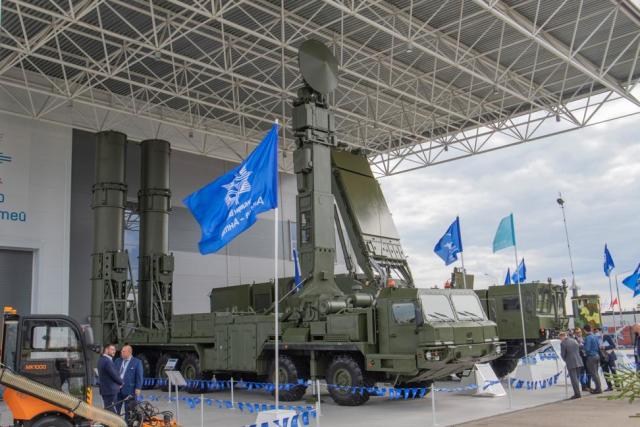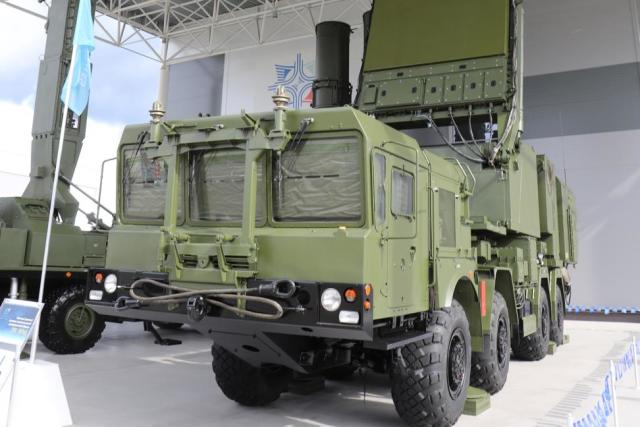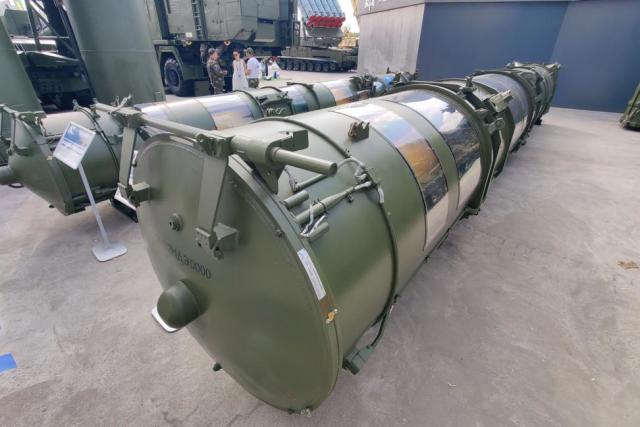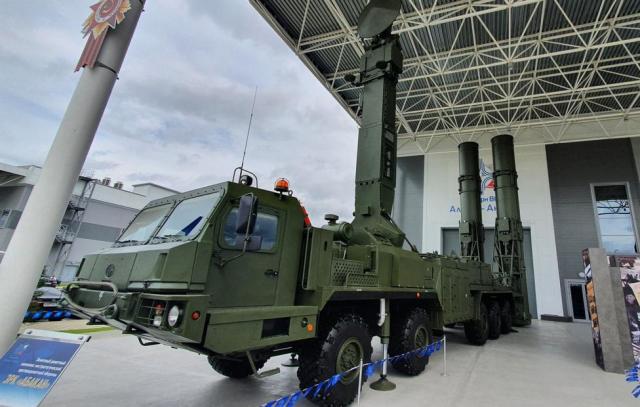TASS — about the new Russian missile defense system At the IDEX 2023 International Arms Exhibition, held in Abu Dhabi (UAE) in February, Russia presented to foreign customers a layered non-strategic missile defense (ABM) system consisting of three elements: an intelligence subsystem, a control subsystem and a three-echelon fire damage subsystem.
It was created on the basis of Russian air defense-missile defense systems.Its first element serves to destroy medium-range ballistic missiles using long-range anti-aircraft missile systems (S-400 "Triumph", "Antey-4000" or "Abakan").
The second echelon includes medium-range complexes ("Vityaz", "Viking"), which are designed to hit operational and tactical missiles. The third echelon, which includes the Pantsir-S1M short-range anti-aircraft missile and cannon complex, is designed to defeat rockets and elements of high-precision weapons.
Among these systems, it is worth highlighting the anti-aircraft missile system (SAM) of the non-strategic missile defense (NPRO) 98P6E "Abakan". Created by specialists of the Almaz-Antey concern of East Kazakhstan Region, it is able to fill a new niche in the arms market. According to experts, at the moment it has no analogues in the world, and together with practicality and reliability, it is able to attract potential buyers from the Middle East. Another advantage for the interest of foreign customers may be the attractive price of the complex. Experts note that the Abakan is the world's first specialized complex designed to combat high-speed high-altitude targets with ballistic trajectories.
The existence of the Abakan project became known on the eve of the opening of the Army 2020 military-technical forum. Then the exhibition for the first time showed a self-propelled launcher (SPU) 51P6E2 from the NPRO air defense system, including it was noted that the project was designed specifically for the international market. A full-fledged sample was presented for the first time at Army-2021.
 |
| The Abakan air defense system is a 51P6E2 launcher and a 98L6E radar. |
| Source: Viktor Bodrov/ TASS |
Its foreign premiere took place at the Dubai Airshow 2021 in the UAE. And even then, the new air defense system attracted the attention of foreign experts and the media. However, it is still unknown whether it was possible to interest real customers.
What does the complex consist of
The Abakan air defense system includes a highly mobile multifunctional radar for detecting and tracking ballistic targets 98L6E "Yenisei" on a chassis with a 4x4 wheel formula, as well as several highly mobile self-propelled launchers (PU) 51P6E2 on a chassis with a 5x5 wheel formula. This station steadily accompanies aerial objects with a very small reflective surface.
The number of PU in the "Abakan" is determined by the combat mission. Each launcher has two cylindrical launch containers with 9M82MDE anti-aircraft guided missiles and a disk fire control radar that can be raised vertically. In the horizontal marching position, the fire control radar is located between the containers with missiles. The mass of the PU with ammunition is 53.5 tons. The minimum combat crew is five people.
Shooting and combat work in motion is impossible, but preparation for them takes minimal time. Deployment of the complex from the march — no more than 15 minutes, and preparation for firing from the deployed state — about 3 minutes.
Practicality and reliability
The head of the Bureau of Military-Political Analysis, Alexander Mikhailov, in a conversation with TASS, expressed the opinion that Abakan should attract potential buyers from the Middle East with its practicality and reliability. "The complex is practical, it is not a Doomsday air defense. It will be used for more modest, let's say, purposes, but very effectively, like all Almaz-Antey products. In fact, this is an export version of the complex already in service," the expert said. — All possible tests and activities related to the testing of certain types of its characteristics have already been carried out. <...> Therefore, the Abakan complex is proven, reliable, and the eastern buyer can be sure of its technical characteristics."
 |
| Multifunctional radar for reconnaissance and target designation 98L6E from the anti-aircraft missile system 98R6E "Abakan". |
| Source: Viktor Bodrov/ TASS |
The main objective of the complex is to defeat tactical and operational-tactical ballistic missiles, interception of such targets is carried out at a range of up to 300 km and an altitude of up to 25 km. The target speed is up to 3.5—4 km/s.
Effective use
The Abakan air defense system is capable of intercepting ballistic missiles that threaten important objects, while other targets should be hit by other air defense systems. This separation of targets increases the overall effectiveness of air defense missile defense, since the simultaneous use of "traditional" SAM and "Abakan" helps to use their technical potential more effectively. The complex will focus on aerodynamic targets, and Abakan will deal with all ballistic threats.
According to Mikhailov, the complex complements strategic missile defense and will be of interest to states that have serious competitors and serious military conflicts with the use of precision weapons are planned. "It is for such states that the Abakan is needed. It is not as expensive as the S-400, but its capabilities are much more powerful in range, the capabilities of its radars, and so on," Mikhailov believes.
 |
| A transport and launch container with a 9M82MDE anti-aircraft guided missile. |
| Source: Viktor Bodrov/ TASS |
The specialist also noted the attractive price of the Russian complex. "Abakan" is less expensive, which is very important for buyers. In fact, it is adapted to the realities in which the countries of the Eurasian and Asian space are now located. This complex is not initially aimed at shooting down intercontinental missiles or other strategic offensive weapons. The Abakan air defense system is aimed specifically at working on targets that may be in military conflicts in this space. That is, planes, helicopters, attack UAVs, ballistic missiles of various ranges, new generations of cruise missiles," the specialist stressed.
There are no competitors
Now the global arms market offers a wide variety of anti-aircraft missile systems capable of performing air defense and missile defense tasks. At the same time, specialized systems designed to combat only non-strategic ballistic threats are not yet available. Therefore, it is safe to say that Abakan has no direct competitors.
"This is a complex that I don't see any competitors at the moment. China is developing its national air defense and missile defense systems very well now. He already has mobile complexes — analogues of our S-300. Perhaps somewhere Chinese products can compete with "Abakan". And we should not forget that in many ways our technologies also took place there," Mikhailov noted.
According to him, the complex can be used with great efficiency to defeat non-strategic missile defense targets and at the same time save the customer money. "For example, an impact UAV worth half a million dollars. To destroy it, you will have to spend a rocket worth $ 2-3 million. It is very expensive for the customer. You can spend a cheaper missile of the Abakan complex and shoot it down with the same efficiency," the expert added.
Thus, the specialists of the Almaz-Antey concern of East Kazakhstan Region have developed and created a new complex that is already capable of dealing with complex goals. It has completely passed all tests and is ready to be adopted by Russia's foreign partners.
At the same time, the buyer, in fact, acquires together with the complex another echelon of NPRO. "The customer who buys the Abakan air defense system has another echelon of its missile defense, and this is the echelon of non-strategic missile defense. If the customer already has a strategic missile defense system, for example, S-400, he needs such a link of transition between medium-range complexes that covers any objects from, say, UAVs, military aircraft, helicopters. And the customer needs a higher-level complex, but not as expensive as the S-400. This intermediate link of non—strategic missile defense is taken over by Abakan," Mikhailov concluded.
Competition will naturally arise in the arms market, but the title of the progenitor of the whole direction of anti-aircraft missile systems will remain with the Russian complex. "Abakan" can integrate into any air defense system - work in conjunction with foreign anti—aircraft missile systems. And this expands the capabilities of the grouping of any state to repel a massive attack by enemy ballistic missiles.
Evgeny Vagin, Roman Azanov

